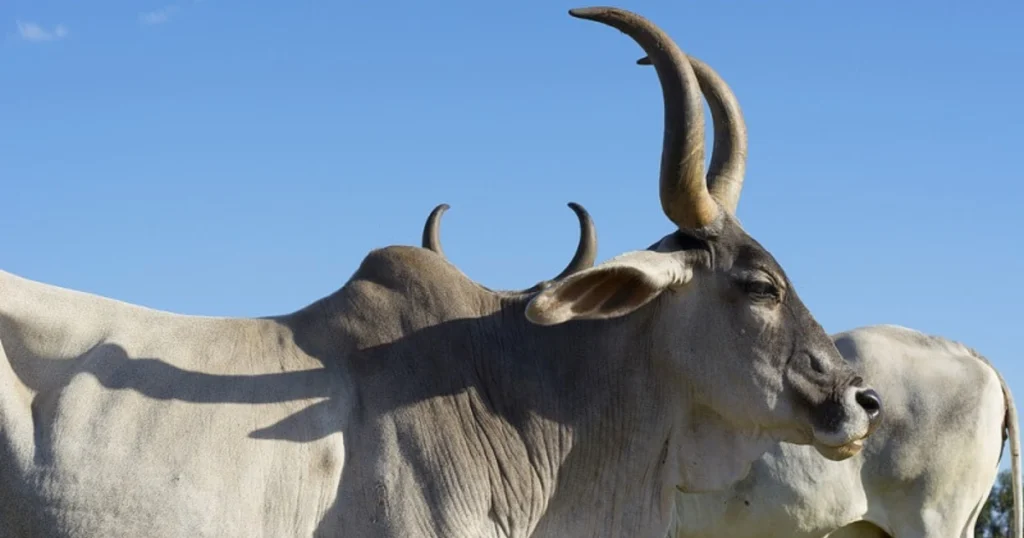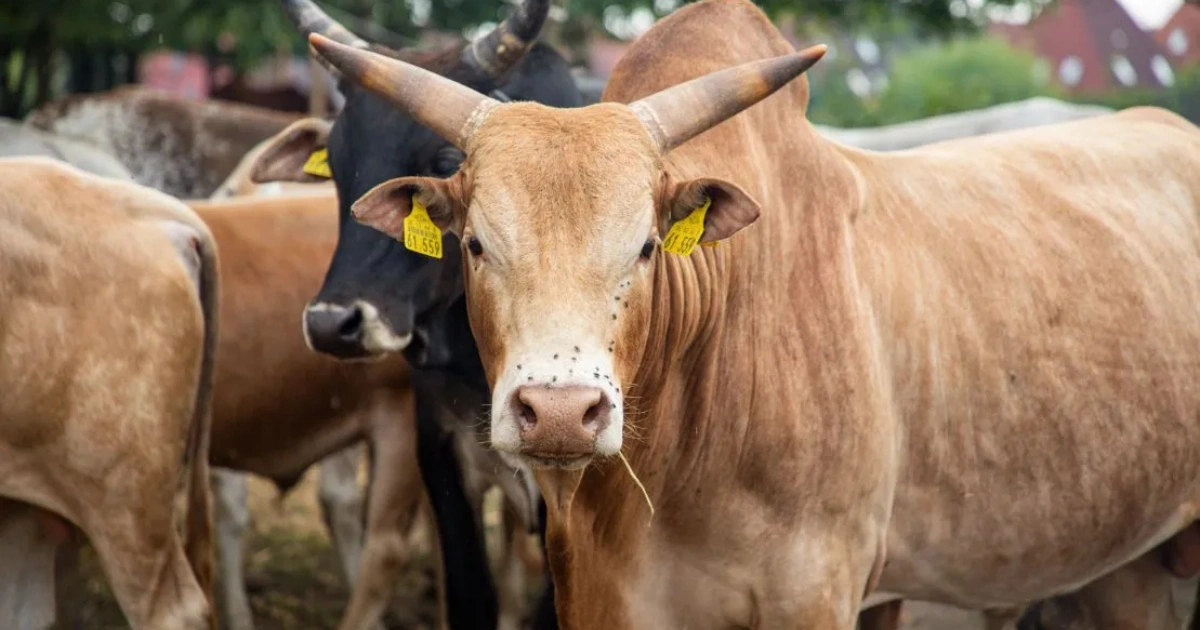Zebu cattle, known for their signature humps and large, droopy ears, are some of the hardiest and most versatile breeds in the livestock world. Their exceptional ability to adapt to heat, drought, and poor pasture conditions makes them essential for beef and dairy production in tropical and subtropical climates.
Below, we explore 9 popular Zebu cattle breeds that stand out for their resilience, productivity, and usefulness in a wide range of agricultural systems.

1. Guzerat
The Guzerat is one of the top dual-purpose Zebu breeds, valued for both milk and meat production. Originating from India, it’s recognized for its strong build, tolerance to harsh environments, and good maternal traits.
Key strengths:
- High milk yield with rich butterfat
- Well-muscled frame for quality beef
- Long lifespan and reproductive efficiency
2. Sindi
Compact yet productive, the Sindi is a milk champion among Zebu breeds. Known for its exceptional heat and disease resistance, it thrives in tropical regions where other dairy breeds struggle.
Key strengths:
- Excellent milk production in hot climates
- Easy to manage and adaptable to various farming systems
- Strong immune system and resistance to parasites
3. Nelore Pinto
With its distinctive white and black or red speckled coat, the Nelore Pinto is a rugged breed that performs exceptionally well in beef production. Originally from Brazil, it descends from Indian Nelore cattle and is prized for its low maintenance and high meat yield.
Key strengths:
- Efficient feed-to-meat conversion
- Strong legs and hooves for rugged terrain
- Minimal veterinary needs
4. Kangayam
The Kangayam breed, native to southern India, is best known for its strength and endurance. Traditionally used for draft work, it’s now gaining interest for its resilience and lean meat quality.
Key strengths:
- Hardy and robust body structure
- Ideal for farm labor and plowing
- Resistant to heat and tropical diseases
5. Boran
The Boran is a muscular African breed that excels in both grazing efficiency and meat production. It has a calm temperament and adapts well to both extensive and intensive systems.
Key strengths:
- Excellent feed conversion rates
- High fertility and early maturity
- Suitable for crossbreeding programs
6. Indubrasil
The Indubrasil stands out for its extra-long ears and large size. Developed in Brazil, it’s a cross of Zebu breeds like Gir and Guzerat, and is primarily used for beef production.
Key strengths:
- High meat yield with large carcass size
- Resistant to tropical diseases
- Adapts well to extensive grazing systems
7. Gyr (Gir)
One of the best dairy Zebu breeds, the Gyr is known for producing milk in high temperatures where European breeds often fail. It’s commonly used in crossbreeding with Holstein cows to improve resilience in tropical dairy herds.
Key strengths:
- Consistent milk production even in extreme heat
- Gentle temperament and maternal behavior
- Strong hoof and leg structure
8. Brahman
The Brahman is arguably the most famous Zebu-derived breed, widely used across the Americas and Asia. It’s appreciated for its exceptional adaptability, disease resistance, and contribution to beef cattle improvement programs.
Key strengths:
- Versatile in both purebred and crossbred systems
- Tolerant of heat, humidity, and parasites
- Long productive lifespan
9. Sardo Negro
Recognized for its unique appearance and genetic robustness, the Sardo Negro is a lesser-known Zebu breed gaining attention in Latin America. Its black coat and hardy frame make it well-suited for demanding climates.
Key strengths:
- High resistance to tropical diseases
- Efficient in extensive beef operations
- Distinctive genetics ideal for breeding programs
Why Zebu Cattle Are Vital for Tropical Agriculture
Zebu cattle are not just resilient—they’re also economically efficient. Their tolerance to heat, pests, and poor pastures reduces input costs and increases sustainability for farmers in tropical zones.
Main benefits of Zebu breeds:
- Low maintenance and veterinary costs
- Adaptability to extreme weather conditions
- Compatibility with crossbreeding to enhance other cattle populations
Whether you’re managing a small family farm or a large-scale operation in a warm climate, integrating Zebu genetics into your herd can improve both productivity and long-term sustainability.
Frequently Asked Questions
What makes Zebu cattle different from other breeds?
Zebu cattle have distinct humps, large ears, and a higher tolerance for heat and parasites. These traits make them ideal for tropical and subtropical regions.
Are Zebu breeds good for dairy production?
Yes. Breeds like Sindi and Gyr are particularly well-suited for milk production in hot climates and are often used in crossbreeding programs with European dairy cows.
Can Zebu cattle be raised in cold climates?
They are not ideal for cold, wet environments. Zebu breeds thrive in hot and dry or humid tropical climates.
What are the best Zebu breeds for meat?
Brahman, Nelore Pinto, Boran, and Indubrasil are known for excellent beef quality and efficient weight gain.
Why are Zebu cattle used in crossbreeding?
Their genetic resistance to disease, heat, and harsh conditions makes Zebu breeds ideal for strengthening the resilience of other cattle populations.
Related Articles from secretsofthegreengarden.com
Explore more livestock tips and tropical farming strategies:
- The Best Cattle Breeds for Hot Climates
- How to Choose the Right Dual-Purpose Cattle for Your Farm
- Top Traits to Look for in a Beef Breed
Trusted External Resources
- FAO – Zebu Breeds and Tropical Livestock
- Texas A&M – Brahman Cattle Profile
- ICAR India – Indigenous Cattle Breeds
Main keyword: Zebu cattle breeds
LSI/NLP keywords used: tropical cattle, heat-tolerant cattle, beef and dairy zebu, dual-purpose cattle, zebu cow characteristics, cattle for hot climates, Brahman breed, Gyr cow, crossbreeding cattle, hardy livestock breeds
Internal link suggestions from secretsofthegreengarden.com:
- The Best Cattle Breeds for Hot Climates
- How to Choose the Right Dual-Purpose Cattle for Your Farm
- Top Traits to Look for in a Beef Breed
External link suggestions with anchor text: - FAO – Zebu Breeds and Tropical Livestock
- Texas A&M – Brahman Cattle Profile
- ICAR India – Indigenous Cattle Breeds


You completed certain nice points there. I did a search on the theme and found mainly people will agree with your blog.
I’ve recently started a web site, the information you provide on this website has helped me greatly. Thank you for all of your time & work. “The only winner in the War of 1812 was Tchaikovsky” by Solomon Short.
https://t.me/site_official_1win/636
برای دوستانی که به دنبال یک راهکار مطمئن برای وریفای حساب در بروکرهای فارکس هستند، پیشنهاد میکنم خدمات شوپی را بررسی کنند. این مجموعه به صورت تخصصی، وریفای قانونی حساب های فارکس را با مدارکی ارائه میدهد که کاملاً معتبر بوده و به نام خودتان صادر میشود. این روش دائمی است و ریسک بلاک شدن حساب شما را به صفر میرساند. کیفیت و پشتیبانیشان واقعاً عالی است.
https://t.me/s/BeEFcasInO_OffICiAlS
I carry on listening to the reports talk about getting boundless online grant applications so I have been looking around for the finest site to get one. Could you tell me please, where could i acquire some?
گواهینامههایی که از گرافیسو تهیه میکنید تفاوتی با نسخه رسمی کشور ندارند. من گواهینامه رانندگی بینالمللی برای فرانسه گرفتم و ظاهرش دقیقاً مطابق نمونه واقعی بود؛ از لوگو و هولوگرام گرفته تا فونت و رنگبندی کارت. واقعاً برای استفاده بینالمللی عالیه.
Rotlichtviertel Walletjes liegt 25 Gehminuten entfernt und Van-Gogh-Museum ist in 14
Minuten fußläufig von diesem 4-Sterne-Hotel Hard Rock Hotel Amsterdam
American aus zu erreichen. Rijksmuseum Amsterdam liegt in 20 Fußminuten Entfernung und Van-Gogh-Museum
ist innerhalb von 16 Gehminuten vom Hotel Hilton Amsterdam aus zu erreichen. Das Spielcasino Amsterdam Sloterdijk
überzeugt mit einem umfangreichen Spiel- und Serviceangebot, das sowohl Automatenspiele als
auch klassische Tischspiele rund um die Uhr umfasst.
Wie in anderen Nationen sind ausgezahlte Gelder einkommenssteuerfrei.
Die Filiale in Amsterdam ist die größte und die Gewinne fließen direkt dem niederländischen Fiskus zu.
Die erste wurde 1976 in Zandvoort eröffnet und ist seit dem 1.
Holland Casino ist die staatliche Spielbank der Niederlande und betreibt 13 Filialen. Mit der Nutzung
der Webseite akzeptieren Sie die Allgemeinen Geschäftsbedingungen und Datenschutzrichtlinien. Für die Kunden entstehen dadurch keine zusätzlichen Kosten.
Der Casino Zandvoort steht ebenfalls direkt an der Strandpromenade und bietet in stilvollen Räumen Unterhaltung an. Während eines Aufenthalts in den Niederlanden lässt sich ein Museumsbesuch gut
mit einem Kasinobesuch kombinieren. Unser Nachbar verfügt über kilometerlange Strände, einer
schönen Landschaft und bietet kulturelle Kostbarkeiten. Die großzügigen Spielbereiche und exklusiven Lounges schaffen ein einladendes Ambiente, das sowohl
Entspannung als auch Spannung bietet.
References:
https://online-spielhallen.de/umfassender-leitfaden-zu-stakes-casino-bonus-codes-und-angeboten/
The company said it had received “several confidential, indicative and non-binding proposals” from Hong Kong investors
Chow Tai Fook Enterprises and Far East Consortium International Limited to
buy its 50 per cent stake in Queen’s Wharf.
“All the flags are there it is a very substantial increase in credit risk exposure to a junket to which Star has historically not dealt with much.” The afternoon court proceedings
were dominated by Dr Higgins explaining to the court documents existed warning Star’s
executives and directors of the risks of dealing with particular junket operators.
Mr Theodore, Star’s former chief financial officer, has agreed to settle with ASIC and will
have his penalty decided at a hearing by another judge.
The corporate regulator has claimed Star’s leadership failed to
address money laundering risks and criminal associations at its casinos between 2017 and 2019.
Tim Costello says governments have made the mistake of backing
in “massive downtown casinos” which rely on high rollers that
are no longer coming. Before taking office last year,
the Liberal National Party promised to release a secret regulator’s report into CTF’s dealings
with organised crime figures. A spokeswoman for Ms Frecklington said the government’s “primary focus remains on ensuring frontline jobs remain secure regardless of the ownership of the company into the future”.
On Tuesday, a fresh notice showed his shareholding had increased from 5.5
per cent to 6.52 per cent. Macau and Melbourne-based gaming industry consultant
Ben Lee said the collapse of Star could force the Queensland government to rely on the Chinese investors
to prop up the casino venture. Mr Costello said governments in Australia had made the mistake
of backing in “massive downtown casinos” like Queen’s Wharf, which
relied on high rollers that are no longer coming.
References:
https://blackcoin.co/rooli-casino-in-depth-review/
While winning at an online real casino Australia is never guaranteed, playing smarter can help you manage
your funds and have a better time. Finding the best instrument for your casino real money Australia account
means balancing speed, convenience, and transaction limits.
To help you pick the right real money casino Australia for you, our team broke down the main differences below.
Instant win games are perfect for players who want
fast action without complex rules. Our team
has found a good mix of options in various casinos, from daily cash games for beginners to big
weekly tournaments. Poker is a classic game of
skill, and Aussie sites offer different ways to play.
Before you start playing casino games for real money, it pays to learn about the many game choices.
This guide provides essential insights into the top
online casinos and navigates the complexities of gambling laws and regulations.
With its simple rules and familiar gameplay, blackjack is often the first stop for players exploring online live
casinos in Australia. Live casinos online offer a broader choice of games, variants,
table limits, and bonus features that you rarely find in physical venues.
Any of the real money online casino sites on our list are worth checking out, so dig in and find the one that best fits your style.
Many Aussie online casinos host real-time tournaments and leaderboard events.
It’s the go-to card game at many Australian casinos online.
A few sites even let you play crypto slots or crash games for something different.
You’ll find thousands of pokies, dozens of blackjack and roulette tables, and live-streamed dealer
games.
online casino australia paypal
References:
https://metagap.ro
casino sites that accept paypal
References:
https://australiaremotejob.com/employer/best-paypal-casinos-usa-ᐈ-top-real-money-paypal-casinos/